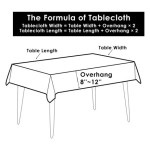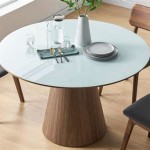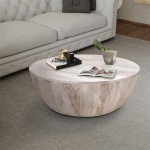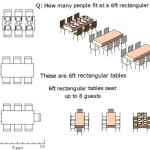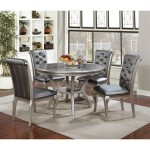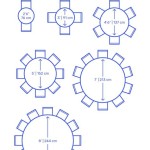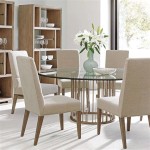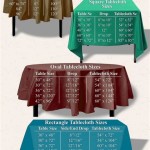How To Find The Perfect Round Black Dining Table Size For 6 Persons
Selecting the ideal dining table involves several considerations, especially when aiming for a specific aesthetic and functionality. A round black dining table offers a sophisticated and often space-saving option for many dining areas. Determining the appropriate size for a table intended to comfortably seat six people requires careful planning and an understanding of spatial requirements.
A dining table is more than just a piece of furniture; it is a central gathering point for meals, conversations, and social interactions. Therefore, choosing the right size directly impacts the comfort and flow of the dining experience. Too small a table can feel cramped and inadequate, while too large a table can dominate the room and hinder movement. The goal is to find a harmonious balance between table size and room dimensions, maximizing functionality without sacrificing aesthetics.
This article provides a detailed guide on how to determine the perfect size for a round black dining table designed to seat six people, taking into account various factors such as spatial needs, table dimensions, and considerations for chairs and movement within the dining area. By understanding these factors, individuals can make an informed decision and choose a table that meets their specific needs and preferences.
Key Point 1: Understanding Spatial Requirements and Room Dimensions
Before even considering the diameter of the round black dining table, it is crucial to assess the available space within the dining area. The dimensions of the room will dictate the maximum size of the table that can be accommodated without overcrowding the space. Measure the length and width of the dining room to obtain accurate measurements.
A general guideline is to allow a minimum of 36 inches (91 cm) between the edge of the table and any walls or other furniture. This clearance allows individuals to comfortably pull out chairs and move around the table without bumping into obstacles. In smaller dining areas, this minimum clearance may need to be strictly adhered to, while larger spaces may allow for greater flexibility.
Consider the placement of other furniture within the dining room, such as sideboards, cabinets, or buffets. Ensure that these items do not impede movement around the table. If the dining room is part of an open-plan living area, consider the flow of traffic and how the table's placement will affect the overall layout of the space. A visual representation of the table's footprint using painter's tape can be helpful in assessing its impact on the room's layout.
Beyond the minimum clearance, consider the overall aesthetic and feel you wish to achieve. A larger dining room might benefit from a slightly larger table to create a more balanced and visually appealing space. Conversely, a smaller dining room may require a more compact table to avoid feeling cramped and overwhelming.
Key Point 2: Determining the Ideal Diameter of the Round Table
Once the spatial limitations are understood, the next step is to determine the appropriate diameter of the round black dining table. The ideal diameter for a table seating six people will directly impact the comfort and functionality of the dining experience. Several factors contribute to this determination, including individual place setting size and the desired level of elbow room.
A standard place setting, including a plate, cutlery, glass, and napkin, typically requires around 24 inches (61 cm) of width. For six people, this translates to a circumference requirement that must be accommodated by the round table's diameter. Generally, a round table with a diameter of 48 inches (122 cm) is considered the minimum size for seating six people comfortably.
However, a 48-inch diameter table may feel somewhat cramped, especially if larger dinnerware is used or if individuals prefer more personal space. A diameter of 54 inches (137 cm) to 60 inches (152 cm) provides significantly more elbow room and allows for easier conversation across the table. This larger diameter also provides ample space for serving dishes in the center of the table.
Consider the intended use of the table. If it will primarily be used for formal dining occasions with multiple courses and serving dishes, a larger diameter is recommended. If it will be used primarily for casual meals, a slightly smaller diameter may suffice. Also, consider the size of the chairs that will be used with the table. Bulky chairs may require a larger table diameter to ensure comfortable seating without overcrowding.
When considering the diameter, also factor in the thickness of the table's edge. A thicker table edge can slightly reduce the usable surface area. While the difference may seem minimal, it can impact the overall dining experience, especially with a full table.
Key Point 3: Considering Chairs, Table Base, and Material Considerations
The type of chairs selected to accompany the round black dining table significantly impacts the overall comfort and aesthetics of the dining area. The size and style of the chairs should be carefully considered in relation to the chosen table diameter. Chairs with arms require more space than chairs without arms, potentially necessitating a larger table diameter to ensure comfortable seating for all six people.
The height of the chair seat and the table's apron (the distance from the table's edge to the floor) should also be considered to ensure adequate legroom. A standard table height is approximately 30 inches (76 cm), while a standard chair seat height is around 18 inches (46 cm). However, these dimensions can vary, so it's essential to measure and confirm compatibility before making a purchase.
The table base also plays a critical role in determining legroom and seating comfort. A pedestal base offers more legroom than a table with four legs, as there are no corner legs to obstruct movement. This can be particularly advantageous in smaller dining rooms where maximizing space is essential. However, a four-legged table may offer greater stability, especially with a larger diameter table.
The material of the table can influence its durability, aesthetics, and ease of maintenance. A solid wood table offers a classic and durable option, while a table with a veneer top may be more affordable. Black finishes can range from matte to high-gloss, each offering a different aesthetic. Consider the overall style of the dining room when selecting the material and finish of the table. Tempered glass tops, while modern, require more frequent cleaning.
Finally, consider the weight of the table. A heavier table will be more stable but also more difficult to move. This is especially important if the dining room is used for multiple purposes or if the table needs to be moved frequently. Consider the flooring of the dining area when making this decision. Heavier tables may require floor protectors to prevent scratches or damage.

Seating Capacity For Round Rectangular Tables

Choosing The Right Dining Table Size Your Ultimate Guide Cabinfield Blog

Oval Dining Table For 6 People

Everything About Your Round Dining Table For 8 People

Choosing The Right Dining Table Size For Your Space Amish Furniture Factory

Everything About Your Round Dining Table For 8 People

How To Build A 70 Round Dining Table Honey Built Home

28 Best Dining Tables For Small Spaces In 2025

Table Size Seating Capacity Round Rectangular More
Dining Table Size Guide For Malaysians Frwd By Cuura Space
Related Posts

